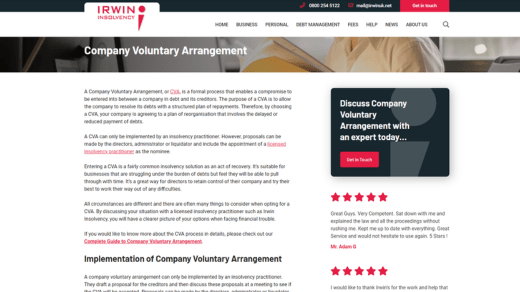
Irwin Insolvency
A Company Voluntary Arrangement (CVA) is a formal agreement between a financially distressed company and its creditors, aimed at restructuring the company’s debts and facilitating its financial recovery. This legal process allows a company to continue trading while repaying its creditors over an agreed period, typically three to five years. Here’s an in-depth look at what a Company Voluntary Arrangement entails, its benefits, challenges, and how it operates:
Purpose and Objectives of a CVA:
- Debt Repayment: The primary purpose of a CVA is to provide a structured framework for the repayment of debts owed to creditors. The company proposes a repayment plan outlining how much creditors will receive and over what period.
- Business Continuity: A CVA aims to allow the company to continue its operations and trading activities without the immediate threat of liquidation or administration. This provides an opportunity for the business to stabilize its finances and return to profitability.
- Avoiding Liquidation: By entering into a CVA, the company seeks to avoid the more drastic measures of insolvency, such as compulsory liquidation. It provides a controlled and managed approach to addressing financial difficulties while preserving jobs and business relationships.
- Creditors’ Interests: A CVA seeks to balance the interests of creditors by offering a better return compared to liquidation. Creditors typically agree to the arrangement because they believe it offers a higher chance of recovering debts compared to other insolvency procedures.
Key Components of a CVA:
- Proposal: The company, with the assistance of an insolvency practitioner (IP), prepares a detailed proposal outlining how it intends to repay creditors. This includes financial forecasts, repayment terms, and reasons why creditors should accept the CVA.
- Creditors’ Meeting: A creditors’ meeting is convened to vote on whether to accept the proposed CVA. For the CVA to proceed, creditors representing at least 75% (by value) of those voting must approve the proposal.
- Supervisor: If approved, an insolvency practitioner acts as the supervisor of the CVA. Their role includes overseeing the implementation of the CVA, ensuring compliance with its terms, and distributing payments to creditors as per the agreed schedule.
- Monitoring and Reporting: The supervisor monitors the company’s financial performance throughout the CVA period, reporting to creditors on progress and any deviations from the agreed terms.
- Effect on Creditors: Once accepted, the CVA binds all creditors, including those who voted against it or did not participate in the vote. Creditors cannot take legal action to recover debts covered by the CVA during its term, provided the company complies with the agreed terms.
Benefits of a CVA:
- Avoids Insolvency: Provides a structured alternative to liquidation or administration, allowing the company to address financial difficulties while remaining operational.
- Debt Reduction: Enables the company to negotiate with creditors to reduce debts or extend repayment terms, improving cash flow and financial stability.
- Business Continuity: Preserves jobs, maintains business relationships, and protects the company’s reputation by avoiding the stigma associated with formal insolvency.
- Controlled Repayment Plan: Provides a clear, manageable repayment plan that the company can afford based on its financial capabilities.
Challenges of a CVA:
- Creditor Approval: Securing creditor approval can be challenging, as it requires a significant majority (75%) of creditors by value to support the proposal.
- Financial Constraints: The company must adhere strictly to the repayment schedule and financial obligations outlined in the CVA, which may require tight budgeting and financial discipline.
- Public Disclosure: Details of the CVA, including financial information and creditor agreements, are publicly available, which may impact the company’s reputation and relationships with stakeholders.
- Risk of Failure: If the company fails to meet its obligations under the CVA, creditors may petition for the company’s winding-up, leading to potential liquidation.
Conclusion:
In conclusion, a Company Voluntary Arrangement (CVA) offers a structured and legally binding mechanism for financially distressed companies to restructure their debts and continue trading. By providing a controlled repayment plan, preserving business continuity, and avoiding the harsher consequences of insolvency, CVAs can be a lifeline for businesses facing financial challenges. However, they require careful planning, negotiation with creditors, and strict adherence to agreed terms to succeed. Engaging experienced insolvency practitioners and legal advisors is crucial for navigating the complexities of a CVA and maximizing its benefits for all stakeholders involved.
Check out Irwin Insolvency.




